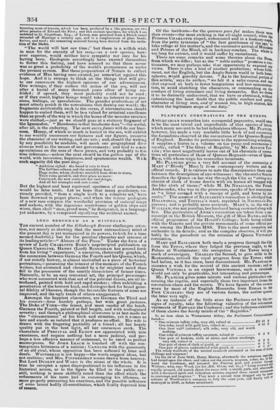PLANCHE'S CORONATIONS OF THE QUEENS.
ANTIQUARIAN researches into ceremonial pageantry, would seem to he the most trivial and unprofitable of that species of labour which many account to be but industrious idleness. Mr. PLANCRt, however, has made a very readable little book of' and concerning the formalities observed at the coronations of the Queens-Regnan of England. Besides its pertinence to the approaching solemnity, It supplies a hiatus in a volume on the pomp and ceremonies of royalty, called " The Glory of Regality," by Mr. ARTHUR TO. Loft; who most ungallantly leaves out of his chronicle of corona. tions all particulars of' those of Queens-Regnant—even of Qom Bess, with whose reign his researches terminate.
Mr. PLasrcHe gives a very full account of the coronation of
MARY ("Bloody" Mary !) from contemporary writers and tbe official records. It is curious to note the discrepancies there exist between the descriptions of eye-witnesses: the chronicler &ram describes the Queen on her way through the City as "sitting ill chariot of cloth of tissue drawn with six horses all trapped with the like cloth of tissue;" while M. Ds NOAILLES, the French Ambassador, who was in the procession, speaks of her conveyance as "a litter covead with a canopy of gold, and borne by tan mules." The account of ELIZABETH'S coronation is abridged from HOLINSHED, and Townes tract, reprinted in NICHOLS'S Pro- gresses; and is probably more accurate, MARY'S, as the wife of Wi LLIAM, was not peculiar, her husband being crowned along with her. The particulars of ANNE'S coronation are taken from a ma- nuscript in the British Museum, the gift of Miss BANKS, and the official programme of the Herald's College; both being coVated with the Gazette and the private memoranda of some official per- son among the Harleian MSS. This is the most complete and authentic in its details; and as the compiler observes, it will pro- bably be the precedent on the occasion of Queen VicrostA's coronation.
MARY and ELIZABETH both made a progress through the City from the Tower, where they lodged the previous night, to the Palace at Westminster; the occupation of the Tower being a mark of sovereignty. CHARLES the Second, to give edit to the Restoration, revived the royal progress from the Tower; which had before, as it has since, been discontinued. Mr. PLANCES sinuates a wish for the revival of this ancient custom; and as Queen VICTORIA is an expert horsewoman, such a cavalcade would not only be practicable, but interesting and picturesque. Mr. PLANCHE gives some minute and curious particulars cot. cerning the regalia, and especially those two important items the coronation-chain and the crown. We have figures of the crowns worn by most of the English Monarchs from EDGAR to the First CHARLES: they are of various forms, the earlier quaint, the later very ugly. As an instance of the little store the Puritans set by the en- signs of royalty, take the following valuation of the coronanon vestments of EDWARD the Confessor ; and the ludicrous exhibition of them shows the hardy minds of the " Regicides:' In an iron chest in Westminster Abbey, the Parliament Commissioner' found-
" One crimson taffety robe, very old, valued at One robe, laced with gold lace, valued at One liver culld (coloured) silk robe, very old, and worth nothing.
1100
nothing.
0
One robe of crimson taffety sarcenett, valued at 0 5 One pair of buskins, cloth of silver, god silver stockings,
very old, valued at 0 2 6 One pair of shoes of cloth of gould, at 0 1 0 0.* One pair of gloves, embroidered with gould, at 0 1 The whole wardrobe of the sainted monarch estimated at the sum ofthirtf shillings and sixpence! On the 3d of June 1643, Henry Marten, afterwards the notorious regiAl. had forced open the chest, and taken out the crown, sceptres, robes,.84c. ol ward the Confessor, and invested the Puritan poet and .satirist (ideoarre Withers; who, says Wood, (in his Ails. Oson. vol. " being crowae royally arrayed, did march about the room with a stately garb, and af tearwa erts with a thousand apish and ridiculous actions, exposed those sacred orpm some to contempt and laughter." They were a second time dragged 11 by
y sold or soldiers ot Westbourne's company in July the same year, and San destroyed in 1649, as before mentioned.


























 Previous page
Previous page